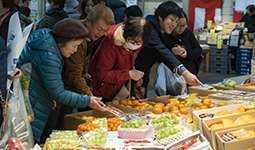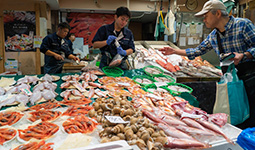Home > Highlighting JAPAN > Highlighting Japan November 2019 > Japan’s Food Culture
Highlighting JAPAN


Kanazawa’s Kitchen and its 300-Year History
Omicho Market in Kanazawa City, Ishikawa Prefecture, which is proud of its history of more than 300 years, is a lively covered market lined with local seafood and vegetable stores that bustle with local customers and tourists all year round.
If you take a ride on the Hokuriku Shinkansen from Tokyo, you can get to Kanazawa City, Ishikawa Prefecture, a city in the Hokuriku region on the coast of the Sea of Japan, in about two and a half hours. Kanazawa is a castle town that was built by the Kaga Clan in the Edo period (1603–1867), and there are still traditional streets and houses and culture in the city. Among other things, Omicho Market, which is located near Kanazawa Castle and is lined with about 180 stores including retail stores and restaurants dealing in fresh fish and vegetables, is popular with the local citizens, and is referred to by the nickname “Omicho.” The covered market is a 15-minute walk from JR Kanazawa Station, and it attracts around 20,000 visitors a day on weekdays and 30,000 visitors a day on weekends.
“Two rivers—the Saigawa River and the Asano River—flow through Kanazawa City, and markets used to be held everywhere along the rivers. The Kaga Clan brought them together in the current location near Kanazawa Castle in 1721, which is said to be the origin of the Omicho market,” says Eguchi Hiroyasu, Managing Director of the Omicho Market Promotion Association.
Omicho flourished in the Edo period as a purveyor to the Kaga Clan. In the Meiji period (1868–1912), the market came to be lined with a wide variety of stores, including wholesalers, brokers and retailers, and developed as the “Citizens’ Kitchen.” A wholesale market subsequently opened in a different location, and Omicho became a market that mainly offered retail stores and food and drink stores selling fresh fish, fresh vegetables and fruit and dressed meat.
Because the market building had aged, a redevelopment project commenced in 2007. Omicho Market Building, a five-story commercial facility, was completed in the corner of the market in 2009. After this new building was completed, the market became lined with stores selling fresh fish and fresh vegetables and fruit again, and the salespeople can be heard shouting, “Low Prices!” and “Fresh produce!” in lively, cheerful voices in the traditional manner.
“At Omicho, seasonal food products are offered each season, such as seafood from the Sea of Japan and farm products called “Kaga Vegetables.” This enables people to experience the cycle of the four seasons in close proximity,” says Eguchi.
Abundant seafood from the Sea of Japan, such as yellowtail, squid, crabs and shrimps, can be found at Omicho. The crabs, in particular, are known for their delicious flavor. The Crab Festival is held every November, when the market comes alive with visitors. In addition, the colorful Kaga Vegetables sold at the market are cultivated mainly in Kanazawa and are resplendent with the sense of the seasons that has been passed down since the Edo period. Typical examples of these vegetables are bamboo shoots in spring, Kaga Futokyuri (thick cucumbers) and Heta Murasaki Nasu (purple eggplants) from summer to fall and Gensuke Daikon (giant white radishes) and Kanazawa Ippon Futonegi (large spring onions) in winter. These seasonal foodstuffs have been arranged on beautiful traditional dishes since the Kaga Clan era, such as Kutani ware and gold-sprinkled Kanazawa lacquer ware, as Kanazawa’s traditional dishes. They are known as “Kaga Cuisine.”
“The most notable feature of Omicho is face-to-face sales. The items are purchased each day and displayed in a store. When selling the products, the salespeople talk to the customers about what food items taste good each day and how to cook them,” says Eguchi.
When the Hokuriku Shinkansen commenced operation in 2015, it brought significant changes to the market. The number of tourists from Japan and overseas visiting Kanazawa City hit seven million, and visitors to Omicho also increased to around 1.6 times the previous number. The “Citizens’ Kitchen” also came to play a role as a tourist site. The Promotion Association gathered store managers and local regular customers, had repeated exchanges of opinions and distributed a market map in both Japanese and English explaining how to enjoy walking around and shopping at Omicho so that both local customers and tourists could enjoy shopping and sightseeing.
“Because the local people use Omicho on a daily basis, tourists can also feel at ease shopping there. Many people who live in suburban areas and usually shop at a nearby shopping center always come to Omicho to go shopping on the days of festivals and celebrations. We want to continue to cherish the unique longstanding appeal of Omicho,” says Eguchi.
© 2009 Cabinet Office, Government of Japan









